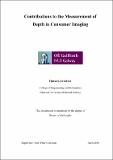Contributions to the measurement of depth in consumer imaging

View/
Date
2018-06-12Author
Javidnia, Hossein
Metadata
Show full item recordUsage
This item's downloads: 258 (view details)
Abstract
This thesis aims to examine and investigate methods that could potentially utilize images captured by consumer cameras such as smartphones to estimate depth and generate a 3D
structure.
After more than a century of research in depth sensing and 3D reconstruction, there are still open and unsolved challenges, and ultimately a practical solution for each problem will have to rely on combining a range of techniques as there is no single best solution which can satisfy all the requirements of a depth sensing application.
Based on this, a number of methods and frameworks are presented to take advantage of the existing consumer cameras in depth sensing applications. A method is presented to postprocess the depth maps with respect to the geometrical structure of the scene. Later, this method is adopted to evaluate the effectiveness of the deep learning approaches in monocular depth estimation. To utilize the current mono cameras available on smartphones, a framework is presented to use the pre-capturing small motions for 3D reconstruction and depth sensing applications. Similarly, a mono camera can be used to capture a sequence of images in different focal planes known as focal stack. A framework is designed to estimate dense depth map from focal stack in a reasonably fast processing time for high resolution images. Lastly, to investigate the potentials of the current consumer multi-camera arrays, a framework is proposed to estimate dense depth map from these cameras.
The advanced capabilities of today’s smartphones brings hope that we can arrive at a consensual depth sensing imaging system in the next decade or so, and hopefully some of the contributions of this research will contribute in part to this solution.

